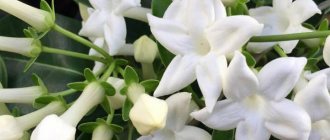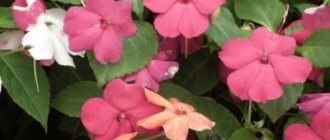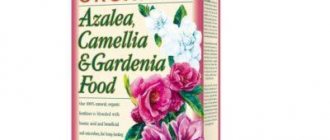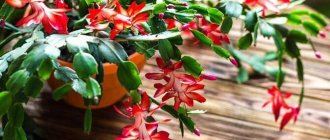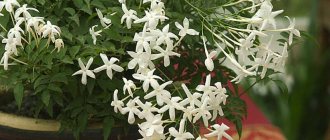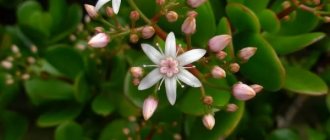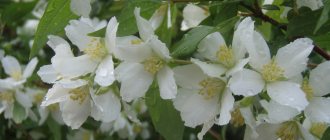Syringa
Garden jasmine (mock orange, Philadelphia jasmine) is the most common summer-blooming ornamental shrub belonging to the olive family. He was always respected in the East; his flowers were considered magical, as if they created harmony. It does not require special conditions and is frost-resistant. Most of its forms are resistant to diseases and pests, but can sometimes be damaged by aphids. Flowers appear in May and bloom until July; they are predominantly white, but may be cream. But some species (Gordon's) may bloom again in the fall. Flowers can reach a diameter of up to five centimeters. During the flowering period, the entire bush is covered with fragrant, white flowers, it seems as if butterflies are about to take off. The flowers are very delicate, at first they are painted white, when they fade they become creamy. Today jasmine has appeared with double and semi-double flowers; before that, simple ones were common. The jasmine bush will bloom when three years have passed after transplanting or planting in the ground. The long flowering of jasmine attracts gardeners, landscape designers and breeders. Therefore, today, according to various sources, up to 200 species of bush have been created.
What year does jasmine bloom and how long does the flowering period last?
Before you worry about how the plant is doing, you need to know what year after planting jasmine blooms. Depending on the variety, you will have to wait from 2 to 4 years.
Jasmine is easy to care for, but to see the splendor of its inflorescences, you will have to make some effort
Differences in the flowering of garden and indoor jasmine
The difference between jasmine that grows in the garden and one that is in a pot in the house is the timing of the release of buds. The plant stays dormant indoors during the winter. The first buds appear around March-April and last until early autumn.
For most outdoor varieties, the active period begins in June and lasts until the first night frosts.
Additional Information! The winter type of jasmine blooms in January-April. Jasmine sambac with white double petals or polyanthus, when creating comfortable conditions, will delight with beautiful and lush inflorescences throughout the year.
Uses of Jasmine
The aroma of jasmine flowers is known to everyone. Over the several thousand years since people have been growing jasmine, they have learned to use it in various areas of their economic activity. Today, jasmine is most often used by people for the following purposes:
- Its extract is used in cooking and perfumery.
- Jasmine is a good honey plant, its flowers attract pollinators from all directions. The honey from its flowers is very tasty and aromatic.
- Dried jasmine flowers are added to tea, it provides a pleasant taste and aroma.
- Early leaves that appear in spring can be used as a salad dressing. They are rich in useful substances. After all, it is in the spring that we experience a lack of vitamins and microelements; these small leaves can provide us with all the necessary nutrients.
- Jasmine leaves have an antipyretic effect. They can be used to make hot compresses to treat ulcers. Garden jasmine root can be consumed raw for insomnia and headaches.
- The most common use of this plant is to decorate the garden; it is loved by landscape designers and ordinary gardeners.
Growing jasmine is not difficult and quite enjoyable, since its long flowering period brings great pleasure and admiration for this plant. Such a flowering bush will always decorate your garden and will always have something to show off to your guests.
Reasons for the lack of flowering in garden and indoor jasmine
Why hydrangea does not bloom - what to do if a garden flower produces only foliage
Knowing how many years it takes for jasmine to bloom, some gardeners note that time passes, but the buds never appear. In such a situation, you need to reconsider the care of the plant.
Lush leaves and lack of buds are a common problem.
Stagnation of moisture or lack of it
The plant loves moderate watering. Its excess leads to rotting of the roots, which is why the bush gradually fades.
When placing a shrub on a site, you need to choose the right place for it. It is prohibited to place the plant in places where groundwater passes close to the ground and in lowlands where water accumulates. Watering rules:
- regular and abundant;
- It is forbidden to use cold water and from the tap;
- watering is carried out with filtered or purified, settled water;
- It is recommended to add a few drops of acetic or citric acid to the water to acidify the liquid;
- if jasmine grows in a pot, the container should have drainage and holes in the bottom to allow residual water to escape.
Additional Information! The top layer of soil should dry out between waterings. Stagnation of water is also detrimental to home jasmine.
Insufficiently acidic soil
Jasmine should only be planted in acidic soil. If the soil is alkaline, jasmine buds will never appear.
Diseases and pests
One of the factors why garden jasmine does not bloom is its damage by insect pests or diseases. Pests:
- Aphids are large, green, and settle on the tops.
- The weevil settles in the soil near the plant and feeds on the sap of leaf blades.
- Spider mite - leaves are dotted with numerous dots, cobwebs are visible.
Diseases are indicated by yellowed or curled leaves, wilting of the entire bush, lack of growth, and falling leaves.
Diseases of the plant often lead to a slowdown in its development
Errors when applying fertilizers
The plant stops producing buds if it receives large quantities of nitrogen fertilizers. They promote the active growth of shoots and leaves, which is why the bush does not have the strength to form inflorescences. Recommended feeding mixture:
- urea 15 g;
- superphosphate 30 g;
- potassium sulfate 15 g;
- water 10 l.
Fertilizers must be alternated using mineral and organic substances.
Inappropriate lighting
If indoor jasmine does not bloom, what should I do? First of all, you need to check where the flowerpot is placed. Despite the fact that this plant is a light-loving plant, the lighting should be plentiful, but diffused, without direct sunlight. The sun causes the leaves to burn and fall off.
Additional Information! It is recommended to place the jasmine pot on the windowsills on the west or east side. On the north side it will not have enough lighting.
Temperature changes
Low temperatures at night and high temperatures during the day have a detrimental effect on the plant. It is easiest to eliminate this factor for jasmine that grows indoors. The optimal temperature is from +18 to +22.
No trimming
If the shoots are not trimmed in a timely manner, the bush will spend all its energy on their growth. Jasmine should be no more than 2 m long. If the height is 3 m or more, there will be no buds. Pruning should be regular, following a number of recommendations:
- Autumn - carried out after all the buds have withered. You need to trim off all dried inflorescences, bad and weak shoots. The cut areas should be treated with garden decoction.
- Spring – until early April. Those shoots that did not survive the winter well, old branches, and leaves left over from last year must be removed.
- Rejuvenating – carried out every 3 years. Old branches are completely cut off.
After pruning, the bush should be watered abundantly.
One of the mandatory measures is regular pruning.
Plant age
A bush that is too young and under 3 years old will not produce buds. All his strength goes into growth and strengthening.
Diseases and pests of jasmine
Jasmine leaves curl, shrink, dry out and eventually fall off - this is most likely due to too low air humidity, lack of moisture in the soil, or because the plant is in direct sunlight. The plant must be removed from the rays or shaded with something; the leaves can be sprayed, but only if the plant is not blooming at this time.
Jasmine pests. The main pests are: aphids, scale insects, spider mites, whiteflies and mealybugs.
Other Possible Flowering Problems
In addition to the lack of buds, the gardener may encounter such phenomena as their too small size or their premature shedding.
Shedding of buds
How to propagate garden jasmine in spring and summer
Jasmine can drop buds prematurely under the influence of the following factors:
- Draft or strong wind.
- Use for cold water irrigation.
- Untimely and incorrect transplantation, when the plant has already begun to produce buds.
- Dry soil, lack of nutrients and minerals.
- Incorrectly selected fertilizer or its use in excessive quantities, which causes the roots to burn.
- Lack of lighting.
Jasmine may drop its buds because the room is too hot or exposed to direct sunlight.
Additional Information! It is recommended to plant jasmine outdoors in partial shade or in a place where the lighting is good but diffuse. It is especially necessary to follow this recommendation when planting a plant in the Moscow region, where summers can be very hot.
Small flowers
Varieties of mock orange with large inflorescences include:
- Mont Blanc;
- Pyramid;
- Schneeshturm;
- Zoya Kosmodemyanskaya;
- Virgin;
- Coronary.
Owners of jasmine with large inflorescences may encounter a problem such as insufficient bud size. This is due to improper care of the plant:
- frequent drying out of the soil;
- absence or insufficient pruning, due to which the plant puts all its energy into the growth of new shoots;
- insufficient refills or their incorrect choice;
- unfavorable location of the plant in the country - the influence of a draft or strong wind, stagnation of moisture.
Establishing care will help normalize the condition. If the plant is in a draft or exposed to direct sunlight, replanting will be required.
Attention! Transplantation is prohibited during the period when jasmine is actively putting out new buds.
Kinds
Jasmine beesianum / Jasminum beesianum
It grows along river banks and in the Western Chinese mountains at an altitude of up to 2.5 km above sea level. Shrubs, vines or evergreens growing up to 2 m in length. The shoots are longitudinal with grooves. The leaves are simple, arranged opposite, lanceolate or ovate, pointed, grow up to 5 cm in length, dark green, slightly pubescent on both sides. This jasmine blooms in May with fragrant, dark pink or pink flowers, growing in diameter up to 1.3-1.7 cm. Flowers grow at the top of the shoots one, two or three at a time.
Jasmine nudiflorum / Jasminum nudiflorum
This species is a shrub, weakly branched, drooping shoots, long and with a small number of leaves. The leaves are bright green, small and trifoliate. In winter, jasmine sheds some of its leaves. This species is called “winter jasmine” because It blooms from mid-winter to mid-spring. Large, egg-yolk-colored flowers grow along the entire stem from the leaf axils.
Grandiflora jasmine / Jasminum grandiflorum
These are vines, shrubs and evergreens with bare shoots that grow up to 10 m in length. The variegated leaves grow opposite each other. Up to seven elliptical-shaped leaves, pointed at the top, are formed on the leaf, the length of which reaches a maximum of 3 cm. At the tops of the shoots, up to 10 fragrant, white and large flowers are collected in an umbrella-like manner. Flowering period from June to October. Flowers of this species are added to tea for flavor.
Jasmine officinale / Jasminum officinale
On the long, smooth, thin and angular branches of this perennial shrub grow two or three paired leaves. The leaves are bright green on top and light green on the bottom of the leaf blade. The smooth leaves are pubescent along the edges and have an elongated lanceolate shape with a point at the top of the leaf. It blooms in April with very fragrant white flowers, arranged in umbrella-type inflorescences on long stalks.
- How to properly care for fuchsia
Multifloral jasmine / Jasminum polyanthum
This weakly branching shrub with climbing shoots grows up to 2 m in height. The dark green leaves are oval in shape, pointed at the top and wavy at the edges. Numerous flowers grow on the tops of the shoots. Three to five narrow-tubular flowers with a bend of five blades are collected. Pink buds. The flowers of this species have the strongest aroma.
Low jasmine / Jasminum humile var. glabrum
It grows in mixed forests of the subtropical part of Western China at an altitude of 1-2.5 km above sea level. Evergreen plants or shrubs with bare shoots, growing up to 2 m in height. The leaves, dark green above and light green below, grow up to 2.5 cm in length, are trifoliate, and can have up to 7 elliptical or ovoid leaves. Fragrant flowers are collected in groups of several in umbrellas. The corolla of the flowers is yellow, up to 1 cm in diameter, as is the corolla tube. Flowering period is summer.
Jasmine turned away / Jasminum humile var. revolutum
The ovoid leaves grow in 5-7 pieces and reach up to 6 cm in length. They have multi-flowered inflorescences with flowers growing up to 2.5 cm in diameter and a tube up to 2.5 cm in length.
Jasmine sambac (Arabic jasmine) / Jasminum sambac
Or Arabian jasmine (Jasminum sambac) . The species is native to tropical Asia. These evergreen plants or vines with thin shoots and pubescent with fine hairs grow up to 6 m in length. The leaves are arranged oppositely in 2-3 pieces, are egg-shaped and up to 10 cm long. Usually round at the base, and either blunt or pointed at the top ; glabrous or slightly pubescent. White double or semi-double flowers are collected in umbrellas of several pieces and smell very pleasant. It blooms from the arrival of spring to mid-autumn. Flowers of this species are added to tea for aroma.
Subtle jasmine / Jasminum gracillimum
Or multi-flowered jasmine (Jasminum multiflorum). It grows in the mountainous part of the northern region of the island. Kalimantan. These shrubs, evergreens or vines have hairy, thin shoots. The leaves are simple, lanceolate-oval in shape, grow opposite and reach a length of 3.5 cm; pointed at the top, and heart-shaped at the base, pubescent below. The flowers are white, fragrant and large. The flowering period is from January to March.
What to do if jasmine does not bloom on your property or at home
Indoor jasmine - how to care
The absence of buds in a plant over 3 years old is a signal to the gardener that he is not caring for it correctly. To restore the condition of jasmine, it is necessary to carry out a number of measures to eliminate negative factors:
- normalize watering - it should be frequent, but without overwatering;
- change, if necessary, the location - diffused light or partial shade is needed;
- change fertilizers. If only nitrogen substances were introduced, it is necessary to alternately use mineral and organic feeds;
- normalize cropping. It should be regular, held in autumn and spring.
If the jasmine is on the street and all measures to resuscitate it have been in vain, it needs to be transplanted. Perhaps it's all about the soil being poor in nutrients and minerals.
Jasmine will thank you for comfort with delicate, beautiful petals.
How to care for jasmine after the flowering period
During the dormant period, caring for jasmine includes:
- reducing the frequency and amount of fertilizers applied using organic matter;
- reducing watering, but without prolonged drying out of the soil;
- pruning;
- preparation for wintering.
Pruning at the end of the active period involves removing faded buds and bad, weakest shoots.
Most varieties of jasmine are frost-resistant. But in regions with severe frosts, it is necessary to build a shelter for the plant, covering it with spruce branches or agrofibre. Young shoots under 4 years of age especially need shelter.
Jasmine is a beautiful plant, with a variety of colors of delicate petals, for which it is so loved. But it happens that it cannot bloom and the reason for this is improper care. To normalize the condition of the plant, it is necessary to create comfortable conditions for it outdoors or in a pot.
